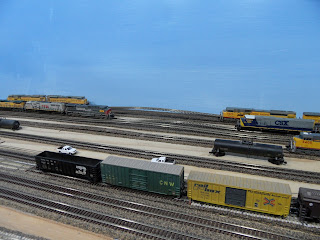The UPRR Geneva Sub hosted an operating session last Sunday afternoon. I was looking forward to the session because it was going to be the first op session with signalling and a full dispatcher. We had ten operators in attendence and the session was going real well. I was dispatching, a couple of guys were working the Proviso/CLinton Yard, an operator was attending to Global III and everyone else was taking turns being road crews. Trains were moving pretty efficiently and everyone was keeping busy for the most part. It turns out however, that things were going a little too well. With so many operators, there were at times up to four trains runing on the mainline along with two sets of yard switchers working Proviso Yard as well as the Global II sitcher and the BNSF local crew. The Digitrax DCC system began to shut down under the strain. At first we thought that there was a short problem somewhere on the layout. However, nothing was ever found and and the shut downs were becoming more frequent as the session progressed. Every time the system shut down, the PM4s went crazy with all 8 power districts tripping in a rythmically random fashion. To get things going again, the system had to be shut off and restarted. We got about 3 hours into the session and were to the point of just 4 or 5 trains left to complete the days work when the shut downs were to the point where I gave up and we ended the session.
Throughout this week, I have been thinking about what may have caused the problems. For a while I thought maybe the battery in the command station was dead. But, even though its been five years since its been replaced, it did not make sense that a bad CMOS battery would cause shut downs like that. Especially since the layout works fine when I operate alone. In thinking about the problem, I keep coming back to the fact that the layout works fine when its just me, but shut down when 10 of us were operating. The difference has to do with load of all those engines running at the same time. I sat down and figured that the shuts downs were occuring when we had around 15 locos running at the same time. With a five amp system, that means that each loco had to draw 1/3 amp each in order to strain the system. Looking at Kato reviews on MR, I saw that Kato locos draw less than .2 amps slipping, so at first that did not make sense. But, then I got to thinking that my Katos have all seen quite a bit service over the years and have accumulated their fair share of gunk which likely has decreased their efficiency and increased their current draw. Add to this the fact that I have a number of tunrouts connected to track power, there are 30 or so idle locos on the layout and there were 6 throttles plugged into the loconet and I think maybe we were straining the power limits of the system. I have been able to recreate the problem, by running 7-8 mutliple consists at the same time. When I recreated the problem, I discounected the PM4s and found out that, when it shuts down, the system makes continuous clicks which the manual says mean a drop in voltage.
So, I have concluded that either I need to add a second 5 amp booster or my power supply is not providing enough volts. Since I am using the Digitrtax 15 volt, 5 amp power supply, I doubt its the problem. I'm leaning more toward not enough power. I'm going to see if I can get a spare booster here so that I can test and see if that is indeed the issue. If so, I will be in the market for an additional booster for the layout.
I'd be interested if anyone else out there has any ideas on what the problem might be. I always try to keep an open mind about such things.





















































